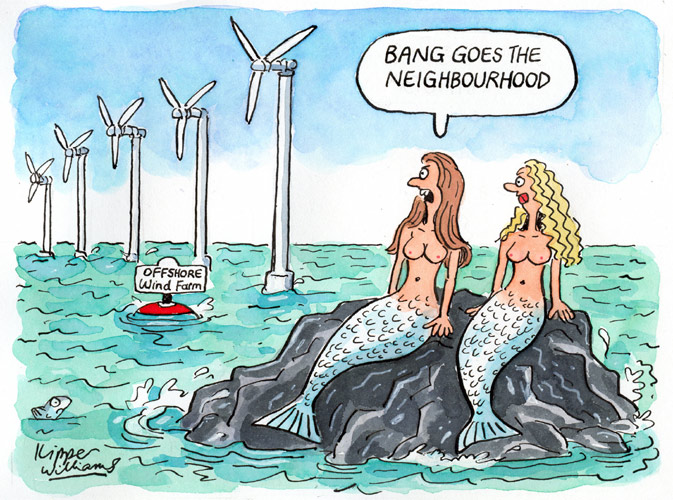He graduated from doodling footballers and cowboys as a child to being paid to pen cartoons for the nationals. We asked Kipper Williams for the inside scoop on doing a daily commission for the Guardian newsdesk and discovered why the funniest stories can also be the trickiest to turn into a cartoon.

What’s your working routine?
I cycle from Hampstead Heath to my studio in Windmill Street, arriving nicely pumped up to start attacking the stories of the day at around 10am. I usually wind up at about 7pm but more often than not there’s a brief to read or a drawing to pencil in when I get home. I haven’t quite shaken off the ridiculous studenty habit of working into the early hours, but I try to avoid that happening too often.
Did you always want to be a cartoonist?
As a child, I obsessively drew footballers and cowboys, graduating to pop stars, schoolteachers and my Dad asleep in the armchair. I loved the Giles cartoons in the Daily Express and was an avid reader of the Beano, so it was a genuine enthusiasm rather than a career plan.
Where can we see your cartoons featured?
I draw a pocket cartoon for the Guardian four days a week and a weekly strip called Pile ‘em High for the Sunday Times Books section. I also appear in The Spectator and the John Lewis Gazette among others, and I’ve illustrated various books including Bill Bryson’s A Short History of Nearly Everything.
How did you get started?
When I was a fine art student at Leeds University I contributed cartoons to the student paper and started getting a buzz from seeing my stuff in print. I won the cartoon section of the New Statesman Student Journalist Competition, spending the £50 prize money on a party with lots of sparkling wine, if I remember. The then editor Anthony Howard was very encouraging and, as I got more (usually student-based) cartoons published in the New Statesman, Melody Maker and Times supplements, I thought cartooning for a living might be an option.
What are the tools of your trade?
Once I’ve written down a list of ideas with a black biro on lined paper (mild obsessive compulsive disorder), I pencil in the cartoon, usually on thin A4 card before dipping a pen with a Golden Shoulder nib into Windsor and Newton black ink and scratching out the drawing. There’s more colour work than black and white these days, so once the ink has dried I splash on watercolour and heavily diluted Dr Martin’s coloured ink. Then I scan in the cartoon and email it to whomever. Delivering artwork by hand is a thing of the past, but I do have fond memories of those days – it was how I met my wife.
What’s your insider tip for other artists?
Buy a black Pentel pen and smash it in half. Pull out the wick, put it into an empty margarine lid and add water. Use this for a fantastic watercolour wash – you can manipulate it on the page like runny honey.
What was the turning point in your career?
One turning point was being asked to draw for Eddy Shah’s Today newspaper. It was the first time I’d drawn cartoons about finance and the City, and it led to me being approached by the Daily Telegraph to draw for them. I worked for the Telegraph for about five years and from there went to draw finance cartoons for the Guardian.
When you draw for a daily paper, how does your commission work?
With the Guardian, I speak to the City newsdesk at lunchtime having been sent the early newslist. I read through all the business sections and check all the websites before putting together around six roughs, which I email to the Guardian towards the end of the afternoon. There are times when nothing quite works, or something is libellous, or stories have changed, so then I go back to the drawing board, but usually a rough is picked and I draw that up in colour before sending it over before 7pm. There’s not much time to do the actual cartoon of course, but I think the drawing is better for that – there isn’t the option to get too fussy.
What are your favourite stories to tackle?
Often the stories that appear quite dull on the surface provide excellent cartoon material. And it’s quite hard to do a cartoon about a story that’s already meant to be funny – man slips on banana skin – hey, let’s have a funny cartoon of a man, er, slipping on a banana skin!
What’s been your trickiest job?
One of my first jobs after leaving the Royal College of Art was to draw bankers for a magazine called Euromoney. I’d be given out-of-date photos of indistinguishable men in suits and had to try to get a caricature out of each one – it was very good training, though.
Anything else?
Ongoing difficulties include drawing people riding bikes and getting a likeness of Jeffrey Archer – he ought to be easy to draw but for some reason I can’t get him.
Kipper Williams, Wordsworth pocket cartoon
Comments